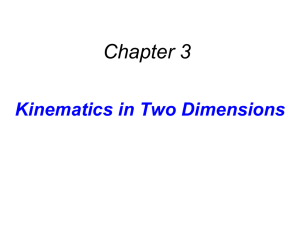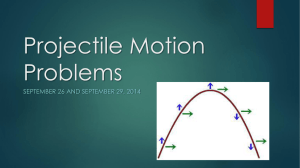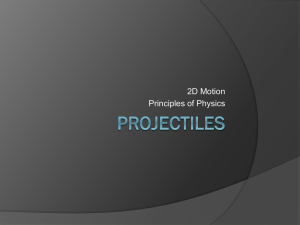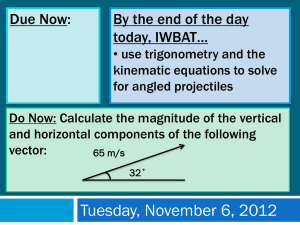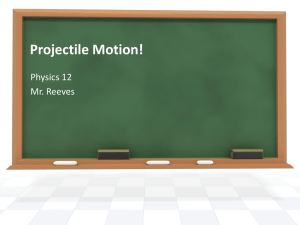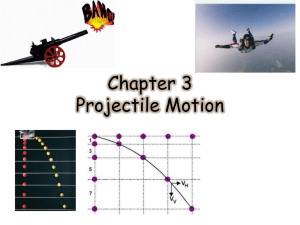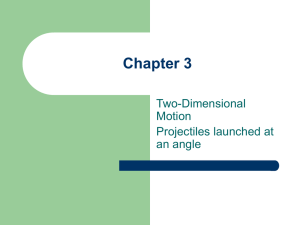Projectiles - Red Hook Central School District
advertisement
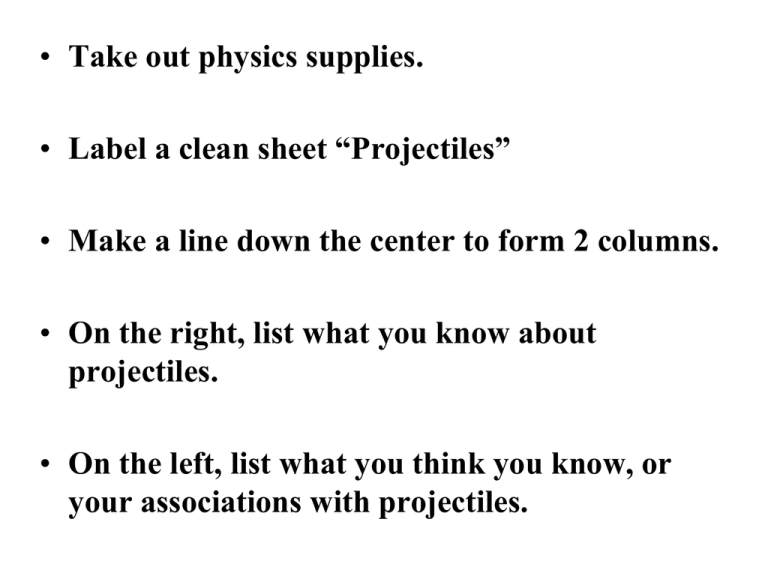
• Take out physics supplies. • Label a clean sheet “Projectiles” • Make a line down the center to form 2 columns. • On the right, list what you know about projectiles. • On the left, list what you think you know, or your associations with projectiles. Projectile Demo: 1. Sketch the path. 2. Does this example describe linear 1 dimensional motion? Explain. 3. Is there any acceleration? Explain. 4. What force(s) are acting on the object? 5. Where during its flight is the velocity the slowest? 6. Where during its flight is the velocity the fastest? Projectiles objects move vertically & horizontally, 2 dimensional, at same time. The only force acting on them is gravity! They accelerate in the vertical direction. They have constant forward velocity in the (horizontal direction). For projectiles launched horizontally – (no initial vertical velocity) the projectile moves forward & down at the same time. The forward & vertical v are separate – they occur independently. The Resultant v is the vector sum of the perpendicular X(horz) & Y(vector) vector components. Horizontal Launch Demo • How does the launch velocity affect the time in the air? • Once launched it’s X (forward or horizontal) v stays constant. • What about the Y (vertical) component? • The Y v is accelerated motion with a = g. • The Y v increases as the object falls. • What about as it rises? German Project clip 4.5 min. ting ting. • https://www.youtube.com/watch?v=z24_ihi kEqQ&list=PL3B2111CE2F7C797B Demo Horz launch vs drop. • Strobe position vs. Time 6 seconds. • https://www.youtube.com/watch?v=z24_ihi kEqQ&list=PL3B2111CE2F7C797B Cannonballs Shoot with no gravity, object moves at const. v forever. Trajectory with gravity. Object drops as it falls. Can solve 2 motion equations to find resultant distance, velocity. Resultant trajectory (path) = parabola. Launch w/ no vertical vi V horiz stays const. Vvert starts at zero & increases. Hewitt 9 min with handout • http://www.youtube.com/watch?v=e_L_vm aCvxo&list=PLF062072FFCB1607F Drop from plane no viy vhoriz same as plane. Object stays below plane as it falls. Running off a cliff A cannon fires a cannonball parallel to the ground. What factors control trip time for a horizontal launch? PHET Launch http://phet.colorado.edu/sims/proj ectile-motion/projectileDemo motion_en.html Height Only For a horizontal launch the total trip time is controlled by the launch height! What variable is always the same for horizontal and vertical projectile motion? The only variable that is always the same in the X and Y direction is the trip time! Vocabulary Projectile – object moving in 2 dimensions with constant horizontal velocity and accelerating vertically with gravity. Trajectory – the path of the projectile. Parabola – the shape of the trajectory. Range – the horizontal distance traveled. Worksheet. • Link Intro Projectiles ~ 9 min. • With Questions • Youtube: Project Horizontal launch • http://www.youtube.com/watch?v=e_L_vmaCvxo&feature=relmfu Horizontal Launch Problems Horizontal Launch v is constant use v = d/t. Accl g in vertical. Use an acceleration equation. 1. A cannonball is shot horizontally from a 125 m cliff. Its horizontal velocity is 75 m/s. List the known & unknown horizontal & vertical variables. How long was the cannonball in the air? What was the range of the cannonball? 2. An airplane traveling parallel to the ground at 100 m/s drops a package from 3000-m. • Calculate the time to hit the ground. • How far in front of the target must the package be dropped? • t = 25 s. • d = 2500 m 3. A unicorn runs off a high diving board with a horizontal velocity of 2.8 m/s and lands in the water 7.3 meters in front of the board. • How high is the platform? • 33 m • Hwk MC packet and pg 102 Text Do Now: • For a projectile launched at a constant speed, what variable(s) determine the total trip time? height • For a projectile launched at a constant speed, what variable(s) determine how far forward (range) the projectile will travel? vx, trip time Projectiles Launched at Angles Resultant Velocity The initial velocity is forward & up. The velocity has a horizontal & vertical component at every point - including the initial launch velocity. If we know vx & vy, at a point, we can calculate the total resultant v, from Pythagorean v2 = vx2 + vy2. Resolution of Resultant to Components • Any 2-d vectors (velocity, force, etc) can be described as the sum of perpendicular vectors • v2 = vx2 + vy2. • Often, instead of adding vector components to give resultant, we take resultant & resolve it (break it ) into perpendicular components. If plane takes off at an angle it has a forward and upward velocity component like a projectile. It is useful to break or “resolve” the velocity vector into horizontal & vertical components. Make a rough sketch of its velocity vector relative to the ground. Vector a can be broken down, or resolved into 2 perpendicular components: ay & ax. Ex 1: How fast must a car be moving to stay beneath a plane taking off at 105 km/h at 25o to the ground? • Need horizontal component of plane v. • vx = v cos q. • vx = 105 km/h cos 25 = 95 km/h b. What is the vertical plane velocity from the previous example? • vy = v sin q • 105 km/h sin 25o • 44 km/h Ex 2: The landing speed of the space shuttle is 99.7 m/s. If the shuttle is landing at an angle of 15o to the horizontal: a. How fast is it descending? b. What is its horizontal velocity? • a. 25.8 m/s • b. 96.3 m/s Hwk pg Text pg 94 #2-7. Finish Horz Projectile Prac Sheet. Need Rifle & Ammunition • Bookbags between you & neighbors. What assumptions can you make?? Velocity Vectors • V2 = vx2 + vy2 • viy ± 0. • vx = Vcos q. • viy = V sin q. For projectiles launched at angles, the viy IS NOT zero. The total resultant v is a combination of vx & vy. Find vtot from V2 = vx2 + vy2 . Given vtot we resolve the initial total v into X and Y components. vx = v cos q viy = v sin q. Other Assumptions needed. • • • • • • vx = constant velocity v = d/t. Vertical (Y) motion is accelerated a = g. vy top = 0. This can be vf or vi. t up = t down. viy = - vfy. Same altitude. vy up = vy down. Same altitude. Ex: A cannonball is launched at a 30o angle with a vertical velocity of 20 m/s and a horizontal velocity of 80 m/s. • Make a rough vector sketch of the cannonball. • Calculate its initial resultant velocity. • Calculate the time to reach the high point in its trajectory. • If it lands at the same height as it was launched, calculate its horizontal range. 1. A cannonball is launched at a 55o angle to the horizontal at a velocity of 150 m/s. It lands at the same height from which it was fired. Make a sketch of path of the cannonball and on your sketch make vector arrows to show the horizontal and vertical velocity, and acceleration at 3 different points. Find the initial horizontal & vertical velocity. Find the maximum height. Find the total time of the trip. How far horizontally did it travel? (range). • viy = 150 m/s (sin 55) = 123 m/s • vx = 150 m/s (cos 55) = 86 m/s • Max height vf2 = vi2 + 2ad • 771 m= h. • Tot trip time t = Dv/a • (123m/s) - (- 123 m/s) /-9.81 m/s2. • 25 s. • 2156 m. Finish Projectiles the Sequel • Film Mechanical Universe “Falling Bodies” Hewitt Angle Projectile Launch http://www.youtube.com/watch?v=H-Y4PcV_mto Hanging Monkey Problem Hwk Rev Book pg 37 “Try It” Prb AND Text pg 114 #26, 28, and pg 117 #58a.
